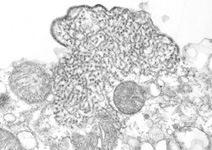Nipah virus encephalitis pathophysiology
|
Nipah virus encephalitis Microchapters |
|
Differentiating Nipah virus encephalitis from other Diseases |
|---|
|
Diagnosis |
|
Treatment |
|
Case Studies |
|
Nipah virus encephalitis pathophysiology On the Web |
|
American Roentgen Ray Society Images of Nipah virus encephalitis pathophysiology |
|
Risk calculators and risk factors for Nipah virus encephalitis pathophysiology |
Editor-In-Chief: C. Michael Gibson, M.S., M.D. [1]
Please help WikiDoc by adding more content here. It's easy! Click here to learn about editing.
Pathophysiology
Hendra virus (formerly called equine morbillivirus) is a member of the family Paramyxoviridae. Nipah virus, also a member of the family Paramyxoviridae, is related but not identical to Hendra virus.
Transmission
Australia, humans became ill after exposure to body fluids and excretions of horses infected with Hendra virus. In Malaysia and Singapore, humans were infected with Nipah virus through close contact with infected pigs.

